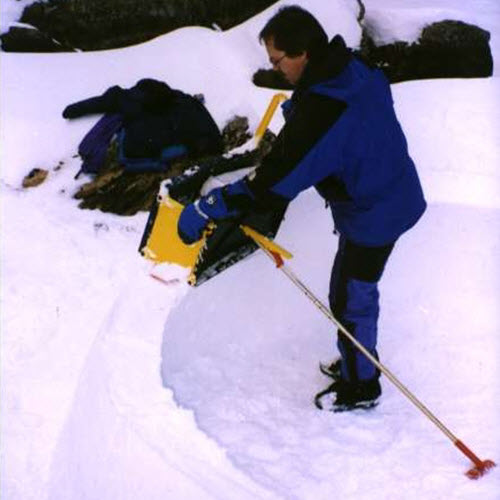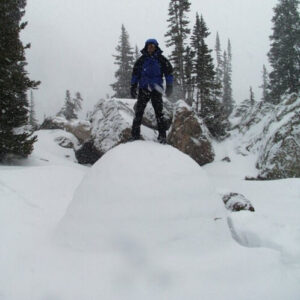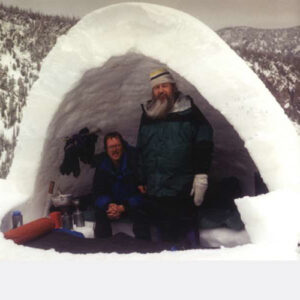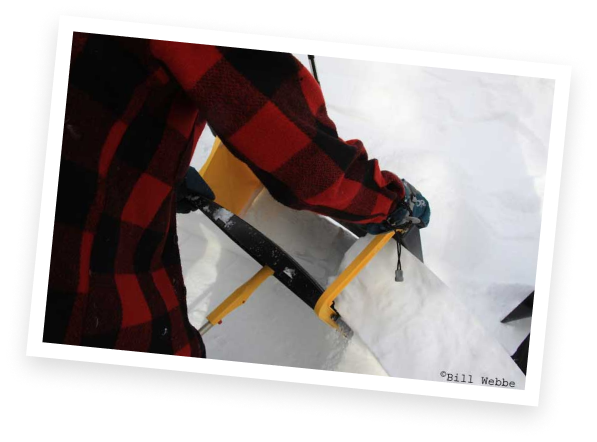Why use the ICEBOX® to build an igloo?

Build an Igloo in any Type of Snow
The ICEBOX® Igloo maker finally controls the snow and speeds up the process of building an igloo. It solves the challenge of building the dome shape and molding the blocks of snow. You can build with any snow conditions allowing you to stay in the woods and out of the wind.
Traditional Inuit igloo builders have always used blocks of hard, compact bricks made of snow to build igloos. However, snow types including sugar snow, slurpee-type ice and depth hoar can be challenging to build with. Igloo Ed found a way to hold the snow together and prevent it from crumbling with the custom designed ICEBOX® igloo maker.
The snow only needs to hold its form well enough to stay in place until you start the next block. 8 total rows are created including the final cap.

Extend the Season
You only need six inches of snow for an igloo. An igloo can be built from surface snow on summer glaciers. ICEBOX® igloos have been built on frozen lakes with only three inches of snow.
Exert Less Energy
Snow shelters and igloos are much easier to build utilizing the ICEBOX® tool and method versus more traditional methods to build a quinzhee or dig a snow cave of equivalent size. Shorter build time will cause less fatigue, plus being outside while building will keep you cool enough to prevent sweating.
ICEBOX® igloo shelter blocks are built in sequence on the wall meaning you are only handling the snow once.
Built in Conveniences
The ICEBOX straps have easy release buckles allowing the builder to keep their gloves or mittens on. The assembled slip form has auto release snaps to prevent the form from breaking if it happens to fall while full of snow. Snaps also help in the assembly of the form allowing the builder to keep their gloves on. All parts are made of bright colors to prevent loss of smaller pieces in snow. The support pole helps create the exact same ICEBOX® Igloo every time. (no guesswork)

The ICEBOX® Igloo Catenary Strength Advantage: What it is and why it’s Important
An ICEBOX® igloo snow shelter is so strong, three people have stood on top of a completed igloo for testing purposes (not recommended).
The actual cross-section of an ICEBOX® igloo snow shelter is self-supporting because it forms a catenary curve. This catenary curve structure of an ICEBOX® igloo is based on a time-tested principle of natural balance and construction also used for European cathedrals. As cathedrals were built higher and higher towards the sky, the outer walls of the cathedral could no longer tolerate the stress placed on them from the weight of the cathedral roof.
No doubt scratching their chins in dismay, ancient engineers finally figured out a remedy in the form of a supplemental wall brace they called “flying buttresses.” They built and placed these catenary curve-shaped stone supports as dueling pressures against the pressures pushing down from the cathedral roof. This is a similar support strategy when building the dome of an igloo.
The ICEBOX® was created to use the same principle when constructing igloos. Snow (and ice) flows with time. Igloos built with snow and having the correct catenary curve shape will have a force of pressure pushing in that is balanced with the pressure pushing down. This advantageous design will keep the ICEBOX® igloo from collapsing and will prevent outward bulging of the igloo walls.
What results is a natural and extremely stable shelter. The occupants inside will remain safe and secure while the igloo building itself will stand rock solid for a good long time, often enduring the length of an entire season.
From the first tier to the roof, an ICEBOX® built igloo remains structurally sound and exceptionally sturdy. The catenary curve structure is an integral feature of the ICEBOX®. Use the ICEBOX® for building igloos and you simply can’t go wrong. That’s what’s so unique about the ICEBOX®.


